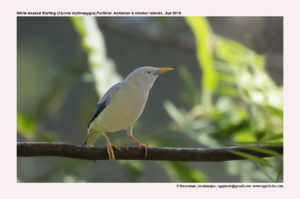
| White-headed Starling Sturnia erythropygia
Etymology:
Vernacular Names: Nicobar: Halue, Haroitch |
Distribution in India: Resident of Andaman & Nicobar in India
Description: Size of 20 cm. It is a small starling with much white in plumage. The nominate race has dirty white from head to upper mantle and down to breast. The lower mantle and back is grey with purple tinge, rump and uppertail-coverts are chestnut; wing is black, green gloss on outer webs; tail is black with green gloss, feathers are with chestnut tips that are broader on outer rectrices, outermost feathers almost wholly chestnut. The lowermost breast and belly are white, undertail-coverts are chestnut; iris is white, grey or bluish; bill is yellow, small blue area at base; legs are yellow. Both the sexes are alike. The juvenile has head streaked brown, tawny fringes on wing-coverts. The race andamensis is greyer than nominate, with less gloss on wings, has rump grey, uppertail-coverts and vent is buffy white, tail lacks chestnut, outer rectrices are white; race katchalensis resembles nominate, but has paler rump and uppertail-coverts and rufous undertail-coverts.
Habitat:It is found in forest clearings, forest edge, secondary woodland and open areas, including grassland and cultivated areas
Food Habits: It eats fruit, nectar and insects. It forages in trees and shrubs; extracts Lepidoptera larvae from rolled bamboo leaves. It is gregarious, forms flocks of varying sizes; joins mixed-species flocks of foraging insectivores which include Drongos and cuckoo-shrikes and minivets. The flocks roost communally in trees.
Breeding Habits: They breed in Mar–May. The nest is made up of twigs, lined with green leaves, placed in tree hole above ground. They lay a clutch of 4 eggs.